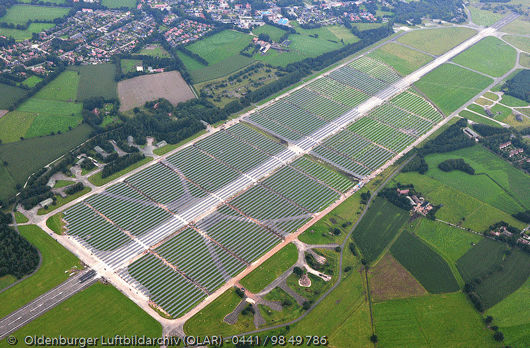- News
16 November 2011
Largest CIGS PV plant opened, using 200,000 Q.SMART modules from Q-Cells
Q-Cells SE of Thalheim, Bitterfeld-Wolfen, Germany, which manufactures both silicon and thin-film copper indium gallium diselenide (CIGS) thin-film solar photovoltaic (PV) modules, has supplied about 200,000 of its Q.SMART CIGS modules to GP Joule GmbH, which was founded in 2009 in based in Reußenköge in the North Frisia region of Schleswig-Holstein and specializes in the realization of solar energy, wind energy and biomass installations.

GP Joule has hence constructed what is reckoned to be the world’s largest solar power plant using CIGS thin-film technology in the record time of just eight-and-a-half weeks. Backed financially by investment firm Aquila Capital, the Solarpark Ammerland plant (in the municipality of Wiefelstede in Lower Saxony) was developed by Stuttgart-based project developer Martin Bucher, while Module24 GmbH & Co KG of Heppenheim, Germany selected the Q-Cells modules for the plant. Q-Cells provided technical support during the installation phase.
The plant was installed on an area of 57 hectare at the former Oldenburg military airbase (taken out of service in 1994, and used for agricultural purposes since 2008). “We’ll be able to bring fallow land back to life and take a further stride, along with the state of Lower Saxony, towards a sustainable electricity system using renewable energy sources,” says GP Joule’s CEO Ove Petersen. “The project clearly shows that there are forward-looking, efficient and economically sound usage ideas available for converted land, and that these ideas can be realised quickly and without too much bureaucratic red tape” he adds.
The grand opening in late October was attended by about 100 invited guests, including Lower Saxony’s Minister President David McAllister, Wiefelstede mayor Helmut Völkers, and Petersen.
With a total capacity of over 20.8MWp, Solarpark Ammerland will supply the electricity needs of more than 6000 households (20 million kilowatt hours per year) and save about 11,800 tons of CO2 emissions annually. “The Ammerland plant is proof of the fact that CIGS thin-film modules are eminently suitable for building efficient, profitable solar power plants,” says Module24’s CEO Marc Weißmüller.
With solar energy conversion efficiency of up to 14.7% in relation to aperture area, Q-Cells says that it has held the record for series-produced thin-film modules since 2009. The performance of Q.SMART modules is boosted by a ‘light-soaking effect’ that can increase output by an average of 2.5% above nominal output in standard field test conditions. Their capacity to produce high yields even when light is poor or the climate is hot makes Q.SMART modules suitable for a diverse range of applications, from roof-mounted systems for residential customers to commercial roof-mounted systems and large ground-mounted installations, claims Q-Cells.
Q-Cells guarantees 100% output in the first three years and states that linear decline in output thereafter will be limited to a maximum of 0.7% per year from the fourth year onward, i.e. the modules still deliver 85% of nominal output after 25 years.
The technology behind Q.SMART was developed in 1983 by the Ångström Solar Center at Uppsala University, Sweden, commercialized by the spin-off company Solibro in 2006, and acquired by Q-Cells in 2009. This March, Q-Cells said it had achieved the milestone of 14.7% production efficiency on the aperture area, a record for monolithically integrated CIGS thin-film modules. At the end of 2010, total production capacity in Thalheim had reached 135MWp.
